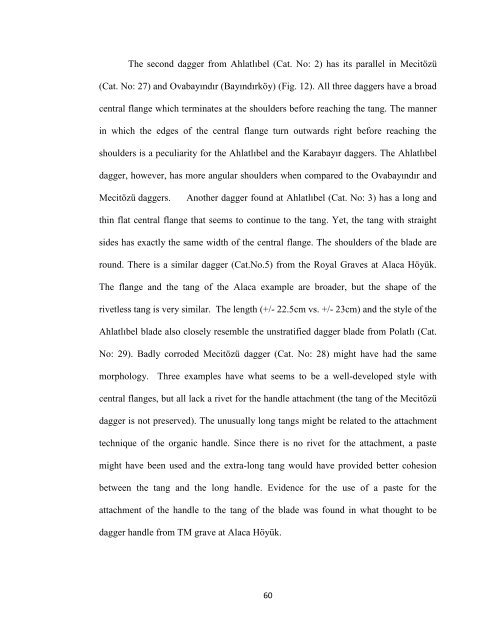EARLY BRONZE AGE DAGGERS IN CENTRAL ... - Bilkent University
EARLY BRONZE AGE DAGGERS IN CENTRAL ... - Bilkent University
EARLY BRONZE AGE DAGGERS IN CENTRAL ... - Bilkent University
You also want an ePaper? Increase the reach of your titles
YUMPU automatically turns print PDFs into web optimized ePapers that Google loves.
The second dagger from Ahlatlıbel (Cat. No: 2) has its parallel in Mecitözü<br />
(Cat. No: 27) and Ovabayındır (Bayındırköy) (Fig. 12). All three daggers have a broad<br />
central flange which terminates at the shoulders before reaching the tang. The manner<br />
in which the edges of the central flange turn outwards right before reaching the<br />
shoulders is a peculiarity for the Ahlatlıbel and the Karabayır daggers. The Ahlatlıbel<br />
dagger, however, has more angular shoulders when compared to the Ovabayındır and<br />
Mecitözü daggers. Another dagger found at Ahlatlıbel (Cat. No: 3) has a long and<br />
thin flat central flange that seems to continue to the tang. Yet, the tang with straight<br />
sides has exactly the same width of the central flange. The shoulders of the blade are<br />
round. There is a similar dagger (Cat.No.5) from the Royal Graves at Alaca Höyük.<br />
The flange and the tang of the Alaca example are broader, but the shape of the<br />
rivetless tang is very similar. The length (+/- 22.5cm vs. +/- 23cm) and the style of the<br />
Ahlatlıbel blade also closely resemble the unstratified dagger blade from Polatlı (Cat.<br />
No: 29). Badly corroded Mecitözü dagger (Cat. No: 28) might have had the same<br />
morphology. Three examples have what seems to be a well-developed style with<br />
central flanges, but all lack a rivet for the handle attachment (the tang of the Mecitözü<br />
dagger is not preserved). The unusually long tangs might be related to the attachment<br />
technique of the organic handle. Since there is no rivet for the attachment, a paste<br />
might have been used and the extra-long tang would have provided better cohesion<br />
between the tang and the long handle. Evidence for the use of a paste for the<br />
attachment of the handle to the tang of the blade was found in what thought to be<br />
dagger handle from TM grave at Alaca Höyük.<br />
60
















